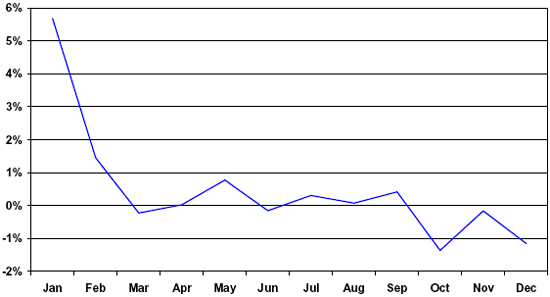Do long-term investors in small-capitalization firms outperform? Is the size effect simply a manifestation of data snooping or defective statistical methodologies? In his January 2006 paper entitled “Is Size Dead? A Review of the Size Effect in Equity Returns”, Mathijs van Dijk reviews the international evidence for the size effect and synthesizes the debate on its theoretical validity and empirical persistence. He concludes that:
- Early studies of U.S. data find that small stocks outperform large stocks on average by 0.4% to 2.4% per month based on raw returns, with the differential most pronounced for very small stocks. The size effect is, however, inconsistent over time. (See first chart below.)
- Small firms outperform large firms based on raw returns in 17 of 18 countries investigated, as well as in a sample of emerging markets and in Europe, with monthly excess returns ranging from 0.13% to 5.06%. However, risk-adjusted results are unclear and sample quality/robustness suspect.
- The four main critiques of size effect studies are: (1) sorting techniques seem arbitrary; (2) a market-based size effect may mask some other risk factor that suppresses market valuation; (3) results are sensitive to the choice of market proxy (benchmark) and therefore suspect; and (4) methodologies ignore the time-varying aspects of risk.
- Various explanations for the excess returns for small stocks are: (1) reward for inherently high risk; (2) compensation for high trading costs; (3) behavioral overreaction to poor past returns; and, (4) a fluke of data snooping or delisting bias or seasonal (mostly January, perhaps tax-related — see second chart below) anomaly.
The following chart, taken from the paper, shows the difference in annual, market-weighted returns between the 20% of all NYSE, AMEX and Nasdaq stocks with the smallest market capitalization and the 20% with the largest market capitalization over the period 1927-2004. These returns are not risk-adjusted. The chart shows that the size effect is not consistent.

The next chart, also from the paper, shows the return differential from the chart above by calendar month. The chart shows that most of the size effect appears in January.

In summary, the empirical evidence for the size effect is superficially consistent, but frail at closer inspection. The size effect is not “dead,” but it is ailing.